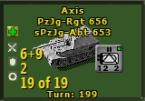Flaviusx
Posts: 7750
Joined: 9/9/2009
From: Southern California
Status: offline

|
quote:
ORIGINAL: Captjohn757
Is anyone aware of any documentation/discussion that addresses the manner or formula used by the designers to arrive at the MPP distribution from the U.S. to the U.K. and Russia? I ask because this particular facet of the game seems appreciably out of sync with what happened historically. The U.S. provided about $50.1 billion in lend-lease to the allies during WWII, the bulk of which went to the British ($31.4 billion) and considerably less to the Soviets ($11.3 billion). Of the aid provided to the Russions, none, of course, was cash, but included all manner of chemicals, communications equipment, railroad locomotives and freight cars, foodstuffs, industrial equipment, clothing, even lipstick, of all things. Only about 20% of the aid constituted military equipment and munitions. Given this general picture, I really don't understand how, in Strategic Command, the Russians, were they following the historical script, could amass the juggernaut of an army and an overwhelming supply of MPPs that players are reporting. Any insight to this phenomenon would be appreciated.
Thanks!
Captjohn757
All that stuff you mentioned allowed the Soviets to focus on military production, without it, they wouldn't have been able to produce anywhere near as much. This logistical support punches well above its nominal weight in terms of dollars or equipment. Essentially, the Soviet war economy outsourced much of its logistical underpinnings to the West.
The game simplifies this, but not incorrectly, unless you want to drown in spreadsheets and minutiae and play Soviet War Economy rather than WW2.
(Roughly speaking, in game lend lease increases the Soviet economy by maybe a third, give or take. This isn't crazy imo, if you look at things in GDP terms and MPPs as a rough and ready stand in for GDP.)
< Message edited by Flaviusx -- 3/6/2017 3:01:48 AM >
_____________________________
WitE Alpha Tester
|
 Printable Version
Printable Version










 New Messages
New Messages No New Messages
No New Messages Hot Topic w/ New Messages
Hot Topic w/ New Messages Hot Topic w/o New Messages
Hot Topic w/o New Messages Locked w/ New Messages
Locked w/ New Messages Locked w/o New Messages
Locked w/o New Messages Post New Thread
Post New Thread